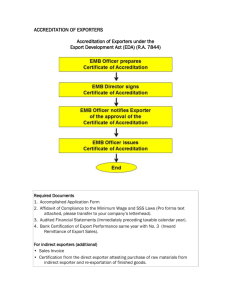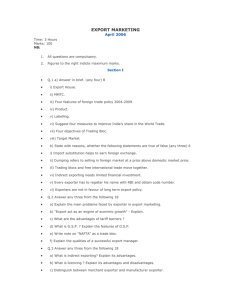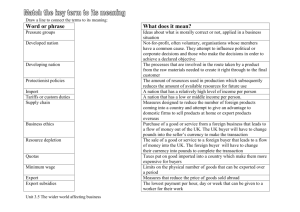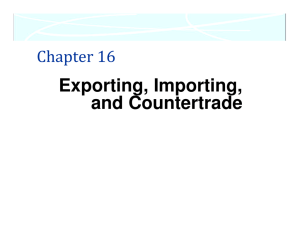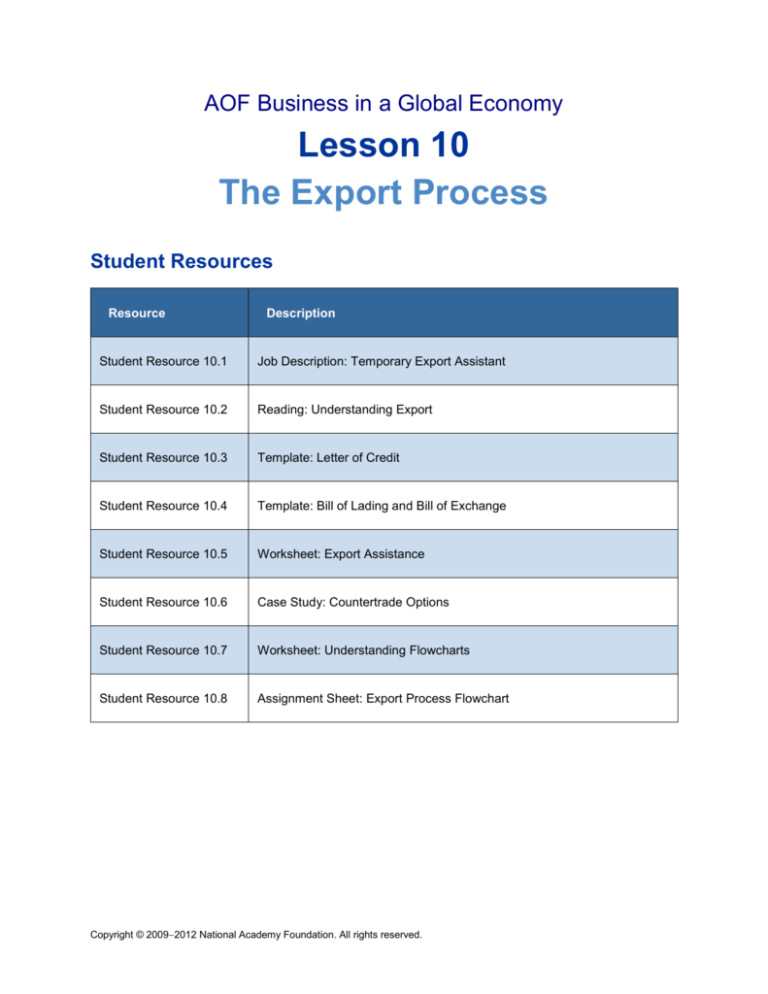
AOF Business in a Global Economy
Lesson 10
The Export Process
Student Resources
Resource
Description
Student Resource 10.1
Job Description: Temporary Export Assistant
Student Resource 10.2
Reading: Understanding Export
Student Resource 10.3
Template: Letter of Credit
Student Resource 10.4
Template: Bill of Lading and Bill of Exchange
Student Resource 10.5
Worksheet: Export Assistance
Student Resource 10.6
Case Study: Countertrade Options
Student Resource 10.7
Worksheet: Understanding Flowcharts
Student Resource 10.8
Assignment Sheet: Export Process Flowchart
Copyright © 20092012 National Academy Foundation. All rights reserved.
AOF Business in a Global Economy
Lesson 10 The Export Process
Student Resource 10.1
Job Description: Temporary Export Assistant
Franklin Export Management Company, LLC
Seeking Temporary Export Assistants
We are an export management firm that assists more than 900 international firms with their exporting
needs, including the preparation and checking of export financing documents and counseling on export
assistance, including financing, regulations, and improving performance. We are looking for seasonal
workers to help our team facilitate export financing and logistics. Candidates must be quick learners who
can follow directions precisely looking for an introduction to the fast-paced world of export management.
This is an unpaid position, but class credit may be available to those who qualify.
Job Responsibilities:
Examine export financing documents for accuracy
Respond to letters of credit by specifying relevant information, including prices and delivery terms
Calculate payments to banks
Arrange shipment of goods
Prepare bills of lading and documentary drafts
Recommend export strategies and opportunities for countertrade
Create a flowchart of the export financing process
Write chapter titles for employee manual
Skills:
An understanding of basic business economics
An understanding of the political, economic, and cultural influences on the global economy
Strong math skills
Excellent attention to detail
Good written and verbal communication skills
Ability to work well with others
Copyright © 20092012 National Academy Foundation. All rights reserved.
AOF Business in a Global Economy
Lesson 10 The Export Process
Student Resource 10.2
Reading: Understanding Export
Companies have many reasons to export their goods to buyers far and wide. In some cases, a business
may simply want to increase the number of potential consumers for its products. In other cases, the
product or service may be better suited to a foreign market than a domestic one. But exporters must deal
with certain issues that domestic-only companies don’t face to the same degree. They must make sure
their goods get to their buyers and that they get paid by buyers who are located in foreign markets.
One of the concerns that exporters have is getting paid for their goods in a timely manner and for a fair
price. Because of distance and currency exchange, it’s often harder to deal with customers who are far
away. But there are ways that an exporter can be assured of receiving payment from a buyer. First, the
exporter must decide how trustworthy a customer is about paying. Based on that determination, the
exporter chooses how the buyer must pay for the goods. The various payment methods available provide
the buyer and seller with differing levels of security.
Copyright © 20092012 National Academy Foundation. All rights reserved.
AOF Business in a Global Economy
Lesson 10 The Export Process
When an exporter sells something on consignment, she ships the items to a distributor in the foreign
country, who will then sell the goods for her. The exporter doesn’t give up ownership of the goods until
they’re sold. In this scenario, there’s no telling how long it will take for the goods to sell, or if they’ll sell at
all. This is why it is the riskiest method for an exporter to use.
When an exporter and a buyer have a longstanding relationship, or the exporter is certain that the buyer
is trustworthy, she may offer an open account. With an open account, the exporter simply sends the
buyer a bill and expects him to pay at some pointusually 30, 60, or 90 days after the sale. Large
companies often buy things using open accounts. The risk with this sort of payment arrangement is that if
something goes wrong and the buyer does not pay, it becomes difficult for the exporter to get the money.
A letter of credit is the safest method of payment for exporters, since banks guarantee the seller that the
payment will be made, and the buyer that the goods will be received on time.
Copyright © 20092012 National Academy Foundation. All rights reserved.
AOF Business in a Global Economy
Lesson 10 The Export Process
Businesses can use a letter of credit to guard the interests of both parties involved in an export
transaction.
Let’s say that Elina is an exporter of gemstones from India and Stanley is her customer in the United
States. Stanley initiates an order for garnets by going to his bank and requesting that a letter of credit be
sent to Elina in India. The bank checks that Stanley has the funds to pay Elina and states the terms of the
sale, including the price he will pay and the date the goods will be shipped to him. When Elina receives
the letter of credit, she examines it, making sure the price is fair and she can ship the garnets in time.
If necessary, Elina requests changes to the terms of the letter of credit and sends it back to Stanley’s
bank. Once all the terms of the sale have been met, Elina receives from Stanley a bill of exchange, or
draft, as it is also known, and based on this she receives payment from her bank for the garnets.
Copyright © 20092012 National Academy Foundation. All rights reserved.
AOF Business in a Global Economy
Lesson 10 The Export Process
A bill of exchange, also called a draft, is similar to a check one would use to pay a bill. One type of a draft,
a sight draft, requires the buyer to pay immediately. Once he’s signed the draft, in effect paying for the
goods, the buyer receives the documents that allow him to claim the goods from the shipper.
Another form of a draft is called a time draft. This draft tells the buyer how much time he has to pay for the
goods. For instance, a time draft might state that the buyer has 60 days from the time he accepts the draft
to pay for the goods. By signing the draft, the buyer agrees to pay within that amount of time. A date draft
is similar to a time draft, but rather than indicate how much time the buyer has to pay for the goods after
signing the draft, it lists a specific date by which the money is due. In this case, it doesn’t matter when the
buyer signs the draft, because he has to pay by the date listed.
Drafts are riskier than a letter of credit, because there is no bank guaranteeing payment. If the buyer
decides not to pay for whatever reason, the exporter will have to deal with the problem.
Because Elina has worked with Stanley before, she is willing to accept a time draft for 60 days in the
future. Stanley agrees to that, so he signs it and sends it to Elina’s bank.
Copyright © 20092012 National Academy Foundation. All rights reserved.
AOF Business in a Global Economy
Lesson 10 The Export Process
The bill of lading is a document that helps ensure that the shipper delivers the proper items to the proper
place. The bill of lading will contain a variety of information about the products being delivered: who is
shipping them, what they are, the quantities, the price, who is to receive them, and so forth. Generally,
the exporter sends the bill of lading to the buyer’s bank. Once the buyer has paid for the goods, he
receives the bill of lading. The buyer then presents the bill of lading to the shipper to receive the goods.
Once Elina gets the bill of exchange that assures her she will be paid for the garnets, she sends the bill of
lading to Stanley. Stanley signs it and thus officially becomes the owner of the garnets. Once this step is
complete, Elina sends the garnets to Stanley, who finally receives the garnets he ordered from Elina.
Copyright © 20092012 National Academy Foundation. All rights reserved.
AOF Business in a Global Economy
Lesson 10 The Export Process
An exporter has several methods at his disposal for selling his goods to customers in other countries. He
must decide what’s best for himself and the buyer based on their business relationship and the
trustworthiness of the buyer.
A letter of credit, for instance, provides the most security for both parties, but it comes with added costs in
the form of bank fees. An open account, on the other hand, makes things easy for the buyer, but involves
much more risk for the seller.
Generally, however, everyone involved wants the same things. They want the transaction to go smoothly,
with the buyer getting his goods and the exporter getting his money.
Copyright © 20092012 National Academy Foundation. All rights reserved.
AOF Business in a Global Economy
Lesson 10 The Export Process
Student Resource 10.3
Template: Letter of Credit
Student Names:______________________________________________________ Date:___________
Directions: Work with your partner to fill in the missing information in this letter of credit according to the
terms outlined.
Terms to be met:
18,000 (9,000 pairs) of the shoelaces should be black, 6,000 (3,000 pairs) rainbow-striped.
The shoelaces come in boxes of 2,000 that weigh 20 pounds each.
The Shining Shoelace company is unable to accept payment for goods after 60 days of shipment
date.
The Shining Shoelace company only accepts US dollars for payment; the price is $0.03 per pair of
single-colored shoelaces and $0.04 per pair of multi-colored shoelaces.
Insurance must be obtained for at least 10% of the value of the shipment, calculated in US dollars.
Shipment must be received no later than 90 days from today or this letter of credit expires.
The exporter must pay the bank 8% of the value of the shipment, calculated in US dollars.
Letter of Credit
Copyright © 20092012 National Academy Foundation. All rights reserved.
AOF Business in a Global Economy
Lesson 10 The Export Process
Student Resource 10.4
Template: Bill of Lading and Bill of Exchange
Student Names:_______________________________________________________ Date:___________
Directions: Work with your partner to fill in these templates based on the terms outlined in Student
Resource 10.3, Template: Letter of Credit.
Bill of Lading
Bill of Exchange
Copyright © 20092012 National Academy Foundation. All rights reserved.
AOF Business in a Global Economy
Lesson 10 The Export Process
Student Resource 10.5
Worksheet: Export Assistance
Student Names:_______________________________________________________ Date:___________
Directions: Match the phone message requesting information with the organization that can help.
Phone Messages
Copyright © 20092012 National Academy Foundation. All rights reserved.
AOF Business in a Global Economy
Lesson 10 The Export Process
Export Assistance Organizations
The Export-Import Bank: a US government agency with the mission to provide financial aid to
firms to facilitate import and export.
The Foreign Credit Insurance Association: an agency that provides insurance for firms unable to
obtain letters of credit. If the firms default on the payment, the FCIA reimburses the insured
company for the loss.
The US Department of Commerce: helps firms with research, including information on the rules
and regulations of export around the world.
The Small Business Association: helps firms understand successful export strategy: entering on a
small scale, adding products only when successful, and hiring locals to promote the products.
Copyright © 20092012 National Academy Foundation. All rights reserved.
AOF Business in a Global Economy
Lesson 10 The Export Process
Student Resource 10.6
Case Study: Countertrade Options
Directions: Decide which method of countertrade would most benefit the firms in the case study. Be ready
to share the reasons behind your decision.
Case Study:
Pinky’s Pencils from Fargo, North Dakota, and the Rubber Tree Plant Company of Bangalore, India, have
been trading partners for the last 19 years. The Rubber Tree Plant Company has provided the erasers for
Pinky’s Pencils and Pinky’s has paid for them with currency. However, because of recent changes in both
firms, they would like to countertrade, but do not know which type of countertrade would be best for them.
Pinky’s, which has seen a 22% increase in demand for pencils over the last fiscal year, is lacking enough
employees to fill all the orders it has. Pinky’s will soon be developing a “green” pencil and is looking for a
partner to invest in research and development for the new pencil. Pinky’s is known for its management
expertise and keeping itself profitable through shrewd decision making.
The Rubber Tree Plant Company has recently lost a major trading partner and is facing layoffs due to the
decrease in business. It has never laid off workers and hopes to avoid doing so, especially its muchvalued research and development team, who created the everlasting eraser. Ironically, the success of the
everlasting eraser has contributed to a decrease in eraser sales, and the company must now reconfigure
its operations or face closure.
Types of Countertrade:
Bartering is when two companies exchange goods and/or services for other goods and/or services.
Bartering does not involve any cash. There are two requirements to successful bartering: the two parties
bartering must agree on how much of each thing traded is worth compared to the other and each party
must have something that the other one wants. Because these two requirements are rarely met, bartering
is not a very common form of countertrade.
In counterpurchasing, a firm agrees to buy products or services from a country where it made a sale.
One interesting feature of this type of countertrade is that purchase of products or services doesn’t have
to be immediate, but could be agreed to be made at a later date or even after goals are met. It can also
be an effective way to enter a new market. One example of counterpurchasing: An airplane manufacturer
in the United States sells jets to the government of a small developing nation. The government agrees to
purchase the planes if the manufacturer will buy some goods produced there, such as tools. The airplane
manufacturer agrees to buy $100,000 worth of tools so that it can break into this new market.
In buyback trading, the countertrade is clearly linked to what the exporter is selling to the buyer. The
exporter agrees to buy back some of what is produced with the equipment or other materials it has sold to
the buyer. For instance, if the exporter is selling manufacturing equipment, it may agree to buy back some
of the finished product made with that equipment. These sorts of agreements tend to be bigger and for a
longer time period than either barter or counterpurchasing.
Switch trading is a form of countertrade that often occurs between businesses and governments or
between governments. If one government owes another a lot of money, it can pay that off by sending its
goods and services to a third country. For example, let’s say the United States has been exporting food to
Bulgaria. If the US builds up enough credit, Bulgaria may decide to engage in switch trading to pay off its
debt. In this case, a third country (France, for example) would export something to the US, but rather than
the US paying for it, Bulgaria would pay for it by exporting something it has to France.
Copyright © 20092012 National Academy Foundation. All rights reserved.
AOF Business in a Global Economy
Lesson 10 The Export Process
Student Resource 10.7
Worksheet: Understanding Flowcharts
Student Names:_______________________________________________________ Date:___________
Directions: Read the rules of thumb about flowcharts and answer the questions about the example. Use
what you learn to fill in the blanks on the Weekly P.E. Activity Flowchart.
Flowchart Rules of Thumb
The title of the process is written at the top of the flowchart.
Each step in the process is written in a box.
The function of a step is indicated by one of three different shapes:
o
Actions go in rectangles.
o
Decisions to be made go in triangles.
o
Start and end steps go in ovals.
Arrows go between each step and show the direction of the process.
Copyright © 20092012 National Academy Foundation. All rights reserved.
AOF Business in a Global Economy
Lesson 10 The Export Process
Example Flowchart: Deciding What to do on Saturday
Questions:
What is the first step in the process?
What are the two choices if you stay indoors?
What are some things you would consider when deciding between reading and playing cards?
Copyright © 20092012 National Academy Foundation. All rights reserved.
AOF Business in a Global Economy
Lesson 10 The Export Process
Weekly PE Activity Flowchart
Copyright © 20092012 National Academy Foundation. All rights reserved.
AOF Business in a Global Economy
Lesson 10 The Export Process
Student Resource 10.8
Assignment Sheet: Export Process Flowchart
Student Names:_______________________________________________________ Date:___________
Directions: Follow the steps on this assignment sheet to complete your export process flowcharts. Check
them off as you complete them.
Flowchart Rules of Thumb
The title of the process is written at the top of the flowchart.
Each step in the process is written in a box.
The function of a step is indicated by one of three different shapes.
o
Actions go in rectangles.
o
Decisions to be made go in triangles.
o
Start and end steps go in ovals.
Arrows go between each step and show the direction of the process.
STEPS
1. Title your chart “Export Process Flowchart”.
2. Write each step on a sticky note and label it with rectangles around actions, diamonds around
decisions.
3. Discuss and decide where to place the sticky notes on chart paper to accurately reflect the export
process.
4. Troubleshoot your chart: make sure each step is in its proper place by going through the flow of
the chart; revise the order of the steps and recheck it until it is accurate.
5. When you are satisfied that the flow is correct, remove the sticky notes and transfer the steps from
the sticky notes to the chart paper.
6. Place the arrows in the right direction between each step.
7. Add the start and finish ovals.
8. Write an explanation of the issues that must be considered for each of the decision steps on the
flowchart—one index card per decision step. Attach the cards to the back of the flowchart.
9. Give and receive peer feedback.
10. Integrate the peer feedback and create a final draft of your flowchart.
Copyright © 20092012 National Academy Foundation. All rights reserved.
AOF Business in a Global Economy
Lesson 10 The Export Process
Before handing in your assignment, check to make sure it meets or exceeds the
following assessment criteria:
The flowchart clearly and accurately portrays the export process from start to finish.
Each step in the process is categorized and labeled correctly.
The arrows accurately depict the order of the steps.
The explanations of the decision-making steps are complete and detailed.
The explanations use correct grammar, spelling, and punctuation.
Copyright © 20092012 National Academy Foundation. All rights reserved.


